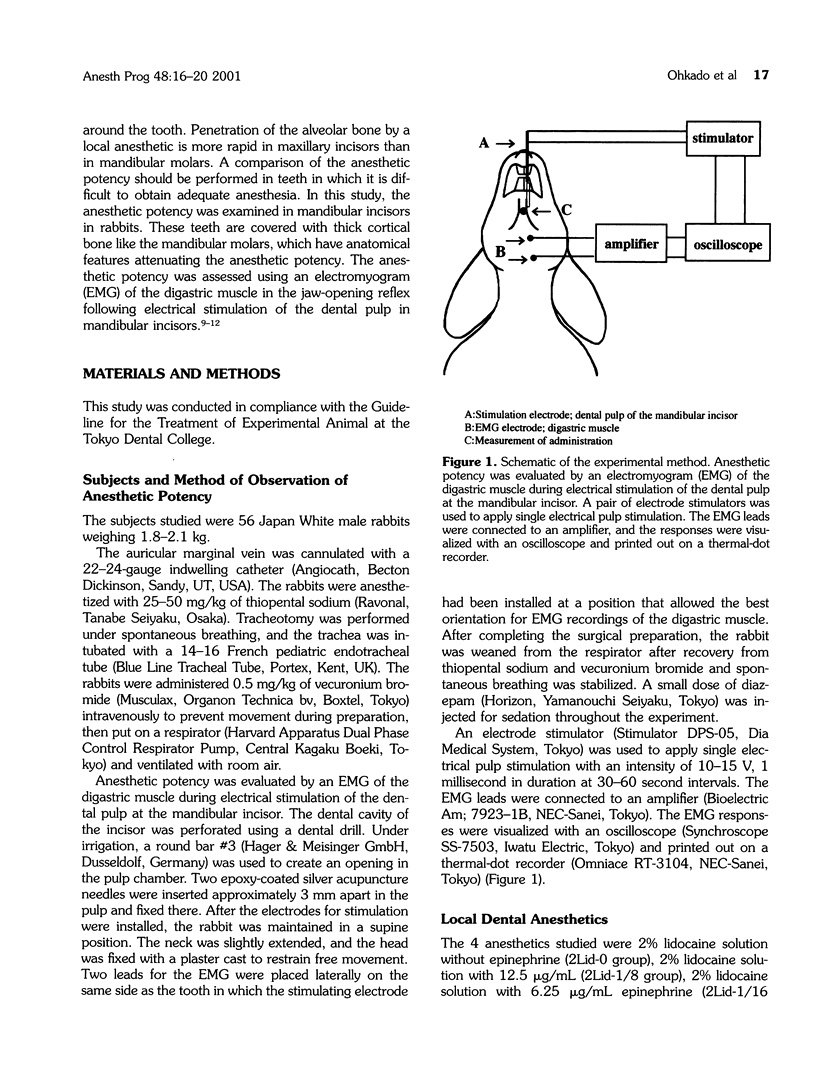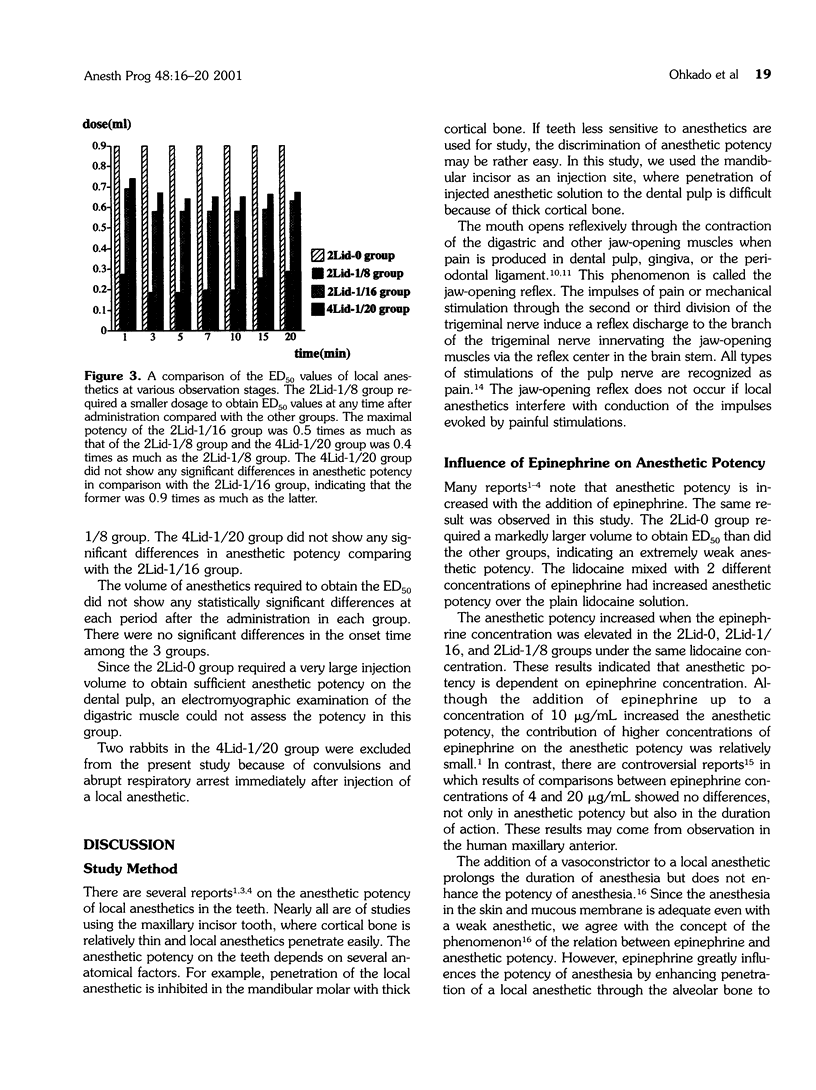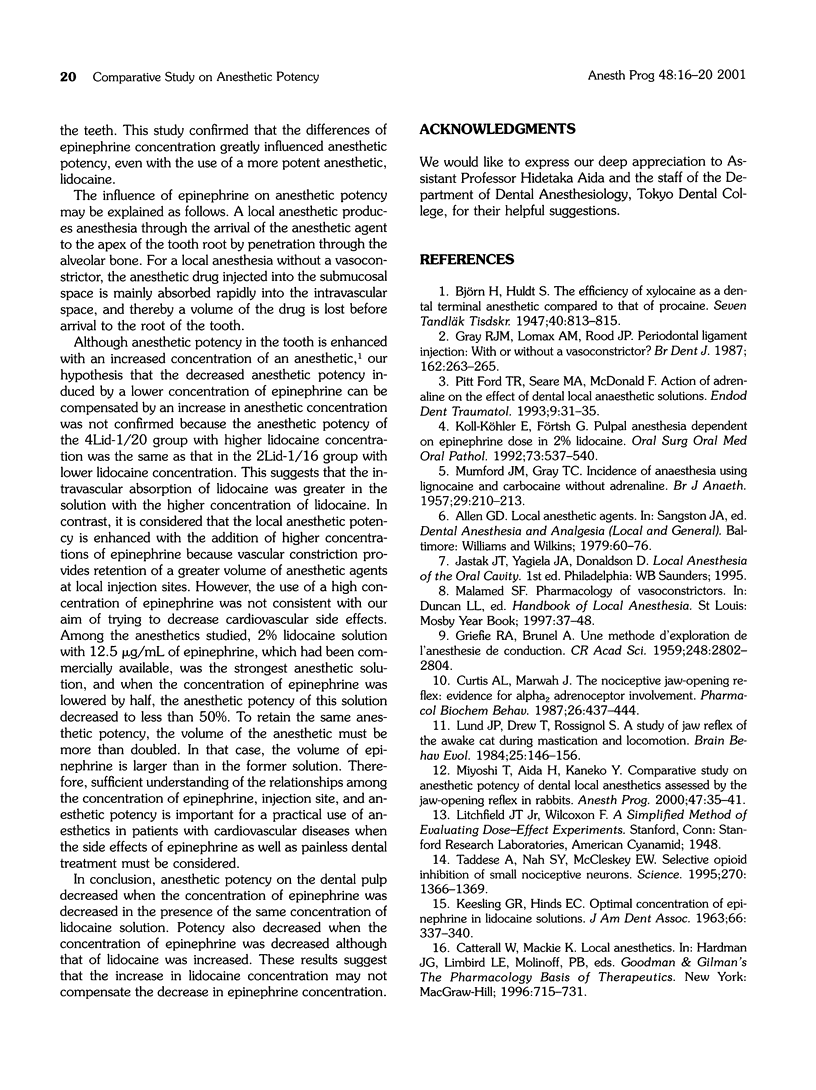Abstract
Anesthetic potency of a local anesthetic on the dental pulp was investigated by increasing or decreasing the concentration of lidocaine and that of epinephrine. An electromyogram of the digastric muscle in Japan White male rabbits was recorded during the jaw-opening reflex induced by electrical stimulation of the dental pulp. Probit analysis was used for the determination of the 50% effective volume (ED50) values of the anesthetic. The anesthetics used were plain 2% lidocaine solution (2Lid-0 group), 2% lidocaine solution with 12.5 microgram/mL of epinephrine (2Lid-1/8 group), 2% lidocaine solution with 6.25 microgram/mL of epinephrine (2Lid-1/16 group), and 4% lidocaine solution with 5 microgram/mL of epinephrine (4Lid-1/20 group). No anesthetic effect was shown in the 2Lid-0 group. The 2Lid-1/8 group indicated adequate anesthetic potency with the smallest dosage at all observation periods. The potency in the 2Lid-1/16 group was 0.3-0.5 times, and that in the 4Lid-1/20 group was 0.3-0.4 times as much as the 2Lid-1/8 group. The decrease in epinephrine concentration produced the decrease in the anesthetic potency on the dental pulp independent of lidocaine concentration. These results suggest that the increase in lidocaine concentration may not compensate the decrease in epinephrine concentration.
Full text
PDF




Selected References
These references are in PubMed. This may not be the complete list of references from this article.
- Curtis A. L., Marwah J. The nociceptive jaw-opening reflex: evidence for alpha 2 adrenoceptor involvement. Pharmacol Biochem Behav. 1987 Feb;26(2):437–444. doi: 10.1016/0091-3057(87)90145-6. [DOI] [PubMed] [Google Scholar]
- GRIFFIE R. A., BRUNEL A. Une méthode d'exploration de l'anesthésie de conduction. C R Hebd Seances Acad Sci. 1959 May 11;248(19):2802–2804. [PubMed] [Google Scholar]
- Gray R. J., Lomax A. M., Rood J. P. Periodontal ligament injection: with or without a vasoconstrictor? Br Dent J. 1987 Apr 11;162(7):263–265. doi: 10.1038/sj.bdj.4806100. [DOI] [PubMed] [Google Scholar]
- KEESLING G. R., HINDS E. C. Optimal concentration of epinephrine in lidocaine solutions. J Am Dent Assoc. 1963 Mar;66:337–340. doi: 10.14219/jada.archive.1963.0108. [DOI] [PubMed] [Google Scholar]
- Lund J. P., Drew T., Rossignol S. A study of jaw reflexes of the awake cat during mastication and locomotion. Brain Behav Evol. 1984;25(2-3):146–156. doi: 10.1159/000118860. [DOI] [PubMed] [Google Scholar]
- MUMFORD J. M., GRAY T. C. Dental trial of carbocaine; a new local anaesthetic. Br J Anaesth. 1957 May;29(5):210–216. doi: 10.1093/bja/29.5.210. [DOI] [PubMed] [Google Scholar]
- Miyoshi T., Aida H., Kaneko Y. Comparative study on anesthetic potency of dental local anesthetics assessed by the jaw-opening reflex in rabbits. Anesth Prog. 2000 Spring;47(2):35–41. [PMC free article] [PubMed] [Google Scholar]
- Pitt Ford T. R., Seare M. A., McDonald F. Action of adrenaline on the effect of dental local anaesthetic solutions. Endod Dent Traumatol. 1993 Feb;9(1):31–35. doi: 10.1111/j.1600-9657.1993.tb00457.x. [DOI] [PubMed] [Google Scholar]
- Taddese A., Nah S. Y., McCleskey E. W. Selective opioid inhibition of small nociceptive neurons. Science. 1995 Nov 24;270(5240):1366–1369. doi: 10.1126/science.270.5240.1366. [DOI] [PubMed] [Google Scholar]


